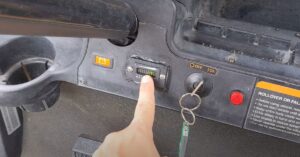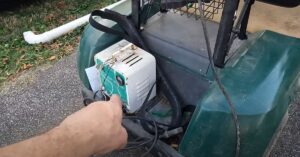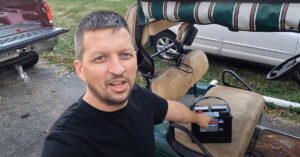Why Is My Golf Cart Not Charging?
Ever experienced that frustrating moment when your golf cart refuses to charge? You’re all set for a round of golf, but your cart seems to have other plans. Well, you’re not alone!
The most common reason why your golf cart may not be charging is due to battery issues. It could be as simple as worn-out batteries or faulty connections causing the problem.
But don’t worry! There’s more to this issue than meets the eye and we are here with some surprising insights. Read on and find out how you can troubleshoot this pesky problem without breaking a sweat!
Key Takeaways
- Ensure all cables are securely attached to the battery terminals for a reliable charge.
- Verify that the charger is properly connected and functioning correctly to ensure efficient charging.
- Use a voltmeter to check if each battery has enough voltage, as low levels could prevent proper charging.
- Regularly clean battery terminals and perform maintenance tasks like watering (if applicable) to optimize charging performance and extend battery life.
Why is my golf cart not charging properly?
If you find that your golf cart is not charging, there could be several reasons behind it. Let’s dig deeper into the most common issues that can prevent your golf cart from charging.
Faulty Batteries
The most common reason for charging problems is often related to the batteries themselves. Over time, batteries can lose their capacity and ability to hold a charge efficiently. It’s essential to regularly check and maintain your batteries to ensure they are in good condition.
Loose or Corroded Connections
Another factor that can disrupt the charging process is loose or corroded connections between the battery terminals and charger cables. These connections need to be clean and secure for an optimal flow of electricity.
Charger Malfunction
Sometimes, the issue lies with the charger itself. A malfunctioning charger may not deliver enough power or fail to initiate the charging process altogether. Inspecting your charger for any visible damage or unusual behavior is crucial.
Wiring Problems
Damaged or frayed wiring within your golf cart’s electrical system can also cause charging difficulties. Check all wiring connections for signs of wear and tear, ensuring they are securely connected without any exposed wires.
How to troubleshoot a golf cart charging issue
If you’re experiencing trouble with your golf cart not charging properly, don’t worry! We’ve got you covered. Let’s dig deeper into the possible reasons for this issue and explore how to troubleshoot it effectively. Troubleshooting Steps:
Check the Battery Connections
Ensure that the battery terminals are clean and securely connected. Loose or corroded connections can hinder proper charging.
Examine the Charger
Assess whether your charger is functioning correctly. Look for any visible damage or loose parts. If necessary, try using a different charger to rule out any issues.
Inspect Cables and Wires
Carefully examine all cables and wires for signs of wear, fraying, or damage. Faulty wiring can disrupt the charging process.
Evaluate Battery Health
Test the batteries’ voltage levels using a voltmeter to determine if they are still in good condition or need replacement.
Remember, safety should always be a priority when troubleshooting electrical systems like golf cart chargers. If you’re unsure about handling any part of these steps, consult an experienced professional who can assist you further.
Are there any DIY solutions to fix a non-charging golf cart?
If you’re facing the frustrating issue of a non-charging golf cart, don’t worry! There are several DIY solutions that can help you get your golf cart up and running again without having to call in professional help. Let’s find out what these solutions are and how they can solve your problem.
Check the Batteries
The first step is to examine the batteries for any signs of damage or corrosion. Make sure all connections are tight and secure. Clean off any corrosion using a solution of baking soda and water, then rinse thoroughly.
Inspect the Charger
Next, inspect the charger itself for any visible issues such as loose wires or damaged components. Ensure that it is plugged into a functioning outlet and turned on properly.
Test the Voltage
Use a multimeter to test the voltage across each battery individually. A fully charged 48-volt system should read around 50-52 volts, while a 36-volt system should read around 38-40 volts.
Replace Faulty Parts
If you identify any faulty batteries during testing, replace them with new ones of the same type and capacity. Additionally, if there are any damaged components in the charger or wiring harness, replace those as well.
Resetting Onboard Computer
Some golf carts have an onboard computer that may need resetting if it detects an issue with charging. Consult your owner’s manual for instructions on how to perform a reset specific to your model.
When should I seek professional help for my golf cart’s charging problem?
If you’re experiencing issues with your golf cart’s charging system, it can be frustrating and time-consuming trying to figure out whether you should attempt a DIY fix or seek professional help. To save you from unnecessary headaches, let’s explore the situations where it is best to enlist the expertise of a professional.
Complex Electrical Problems
If you’ve already tried basic troubleshooting steps like checking connections and replacing batteries but are still unable to identify the root cause of the charging problem, it may be time to call in a professional. They have the knowledge and tools required to diagnose complex electrical issues accurately.
Warranty Concerns
If your golf cart is still under warranty, attempting any repairs yourself could void that warranty. It’s crucial to consult with an authorized technician who can address the issue while keeping your warranty intact.
Lack of Technical Knowledge
Not everyone has experience working with electrical systems or troubleshooting golf carts. If you’re unsure about what steps to take or lack confidence in your abilities, seeking professional assistance ensures that the problem will be handled by someone well-versed in such matters.
Time Constraints
DIY repairs often require research, trial and error, and multiple attempts before finding a solution – all of which can take up valuable time that you may not have available. Opting for professional help allows you to get back on track quickly without sacrificing precious hours on trial-and-error fixes.
FAQs
Q: What are some common reasons why a golf cart is not charging?
A: One possible reason could be a faulty battery charger, which may need to be replaced. Another common issue is corroded or loose battery connections, which can prevent proper charging.
Q: How can I determine if my golf cart’s battery charger is the problem?
A: You can test the charger by plugging it into a different golf cart and seeing if it charges that one successfully. If it does, then the issue likely lies with your own golf cart’s electrical system.
Q: What should I do if my golf cart has loose or corroded battery connections?
A: First, ensure that the batteries are disconnected before attempting any repairs. Then, clean off any corrosion from the terminals using a mixture of baking soda and water. Finally, tighten all connections securely to ensure good contact.
Q: Are there any other potential causes for a non-charging golf cart?
A: Yes, another possibility is a malfunctioning voltage regulator. This component regulates the amount of charge going into the batteries and may need to be replaced if it fails. Additionally, damaged wiring or blown fuses could also prevent proper charging.





![How To Charge A Golf Cart With Dead Batteries? [A Comprehensive Guide] how-to-charge-a-golf-cart-with-dead-batteries](https://giftedgolfers.com/wp-content/uploads/2023/06/how-to-charge-a-golf-cart-with-dead-batteries-300x157.jpg)
